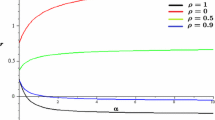Abstract
In this article we consider a size structured population model with a nonlinear growth rate depending on the individual's size and on the total population. Our purpose is to take into account the competition for a resource (as it can be light or nutrients in a forest) in the growth of the individuals and study the influence of this nonlinear growth in the population dynamics. We study the existence and uniqueness of solutions for the model equations, and also prove the existence of a (compact) global attractor for the trajectories of the dynamical system defined by the solutions of the model. Finally, we obtain sufficient conditions for the convergence to a stationary size distribution when the total population tends to a constant value, and consider some simple examples that allow us to know something about their global dynamics.
Similar content being viewed by others
References
Calsina, A.: A non linear model for size-dependent population dynamics, in: C. Perellò et al. (eds), International Conference on Differential Equations, Barcelona 1991, World Scientific Pub. 1993, 345–351.
Cushing, J. M.: A competition model for size-structured species, SIAM J. Appl. Math. 49 (1989), 838–858.
Diekmann, C., Gyllenberg, M., Metz, J. A. J. and Thieme, H.: “The ‘Cumulative’ formulation of (physiologically) structured population models”, preprint (1992).
Dunford, N. and Schwartz, J. T.: “Linear operators, Part I: General theory”, Interscience Pub., New York, 1958.
Grabosch, A. and Heijmans, H. J. A. M.: Cauchy problems with state-dependent time evolution, Japan Jour. App. Math., 7 (1990), 433–457.
Grabosch, A. and Heijmans, H. J. A. M.: Production, development and maturation of red blood cells: A mathematical model, in Math. Popul. Dynamics, Marcel Dekker Inc., New York, 1991.
Gurtin, M. E. and MacCamy, R. C.: Nonlinear age dependent population dynamics, Arch. Rat. Mech. Anal. 54 (1974), 281–300.
Hale, J. K.: “Asymptotic behavior of dissipative systems”, Mathematical Surveys and Monographs 25. AMS Providence, 1988.
Hale, J. K. and Waltman, P.: Persistence in infinite-dimensional systems, SIAM J. Math. Anal. 20 (1989), 388–395.
Metz, J. A. J. and Diekmann, O.: (eds), “The dynamics of physiologically structured populations”, Lect. Notes in Biomath. 68, Springer, 1986.
Metz, J. A. J. and Diekmann, O.: Exact finite dimensional representation of models for physiologically structured populations. I: The abstract foundations of linear chain trickery, in Differential Equations with Applications in Biology, Physics and Engineering (J.A. Goldstein, F. Kappel, W. Schappacher; eds.). Marcel Dekker, 1991.
Rudin, W.: “Functional analysis”, 2nd ed., McGraw-Hill, 1991,
Smith, H. L.: Existence and uniqueness of global solutions for a size-structured model of an insect population with variable instar duration, preprint (1991).
Smith, H. L.: A structured population model and a related functional differential equation. Global attractors and uniform persistence, preprint (1992).
Thieme, H. R.: Well-posedness of physiologically structured population models for Daphnia magna, J. Math. Biol. 26 (1988), 299–317.
Thieme, H. R.: Persistence under relaxed point-dissipativity (with application to an endemic model), SIAM J. Math. Anal. 24 (1993), 407–435.
Tucker, S. L. and Zimmerman, S. O.: A nonlinear model of population dynamics containing an arbitrary number of continuous structure variables, SIAM J. Appl. Math. 48 (1988), 594–591.
Webb, G. F.: “Theory of nonlinear age-dependent population dynamics”, Marcel Dekker, New York, 1985.
Author information
Authors and Affiliations
Additional information
This work was partially supported by DGICYT PB90-0730-C02-01 and PB91-0497.
Rights and permissions
About this article
Cite this article
Calsina, À., Saldaña, J. A model of physiologically structured population dynamics with a nonlinear individual growth rate. J. Math. Biol. 33, 335–364 (1995). https://doi.org/10.1007/BF00176377
Received:
Revised:
Issue Date:
DOI: https://doi.org/10.1007/BF00176377



